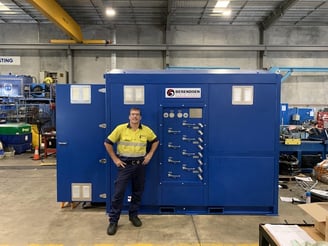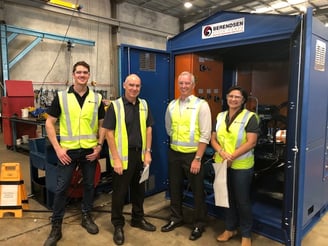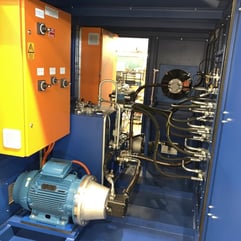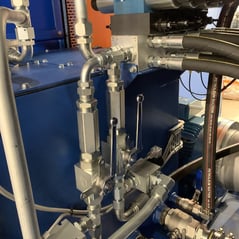If you’re starting a hydraulic system design project, one of the most important factors you’re probably thinking about is the upfront cost to design and manufacture the system. This is of course, a very important factor. However, since this is a system which will need to be run and maintained for years to come, the long term costs associated with the system become a factor that is too important to ignore.
It is not quite as simple as selecting components. Every design decision can have ramifications that may lead to increased wear or increased maintenance requirements, or lower energy efficiency. In this article, we’ll explore this in more detail to give you more information that will allow you to make the right decisions to get the most out of your investment.
Hydraulic System Design: Upfront Cost vs Total Cost of ownership.
.jpeg?width=329&name=IMG_3815%20(1).jpeg)


Hydraulic System - Upfront Costs
The first and most obvious issue to assess is the upfront costs to design, manufacture, assemble and install the system. This is a line item list of costs you will receive in the quote. It may consist of off-the-shelf components and custom-manufactured parts. It also includes the cost in time for the enginee

rs to do their work. Including scoping the project, analysing the application, reviewing the technical requirements and design constraints and drawing up the required plans and diagrams. There is also the time involved to improve the design using reliability engineering methods, including FEA software modelling. And of course, interfacing with the customer at every point along the way.
If custom-manufacturing of components is required, this will also be factored into the upfront costs. In this case, in-house manufacturing is most often more cost-effective for the customer, because it offers more control over the overall cost. It allows the supplier to spread the cost more intelligently, take advantage of economies of scale and reduces the need to negotiate with other third parties.
Also factored-in are the costs of commissioning your system. This includes the cost to transport, install, configure, test and resolve any teething issues - which may occur in custom systems.
The upfront costs involved in designing and manufacturing a hydraulic system are naturally, the thing most customers pay attention to. However, it’s important to note that it is just one consideration - and not always the most important thing you should be thinking about. In the next sections, we’ll discuss the other dimensions of cost that you should consider when deciding which solution to go for.
Hydraulic System - Long Term Maintenance Costs
All systems will require maintenance over time. Hydraulic fluid filters need to be replaced, components will wear out, pumps decline in efficiency and need to be rebuilt, hydraulic hoses, lines and couplings may be exposed to vibrations or shock which causes wear over time.
With all these factors in play, the choices made at the design stage will influence the frequency of the maintenance required and ultimately how much the  maintenance schedule will cost the company over the life of the system.
maintenance schedule will cost the company over the life of the system.
There are many variables that could be taken into consideration. For example, utilising a lower quality pump, or one not optimal for the application, may cost less at the outset, but will probably need to be rebuilt more often. It could also lead to increased hydraulic fluid degradation, which could also increase the frequency that hydraulic filters need to be replaced.
In another example, poor routing of hoses can lead to abrasion or may exceed the minimum bend radius of the hose, which creates high pressure spots as fluid is squeezed through a smaller orifice. This increases heat in the system, leads to hose erosion, fluid degradation and increased maintenance costs.
An experienced hydraulic system designer will consider all of these things in the final design. And the best designers make use of sophisticated computer software to validate their designs. Including 3D modelling software and FEA simulation software - which allow engineers to assess the performance and weak spots in a design and make adjustments.
For more information about all the factors to consider before you initiate a hydraulic system design project, consult our 10 questions guide.
Hydraulic System - Long Term Energy Efficiency Costs

Energy efficiency is an easy thing to overlook when planning a new hydraulic system, however when viewed from a wider time scale, it becomes apparent that what you save upfront will sometimes need to be repaid in increased energy costs down the line.
For example, choosing a more powerful hydraulic motor may in some cases be more energy efficient than using a smaller motor. This is because in some cases a large electric motor running at minimal load can sometimes be more energy efficient than a smaller, cheaper motor running at maximum capacity all the time.
So, while the upfront cost of a smaller motor might be considerably less to start with, the energy costs can far outweigh these initial savings over the life of the system. If you’re a small operation or if the system is not required for heavy daily use, perhaps this is not a significant consideration. However, for larger operations, with multiple systems in place, these design decisions can compound very quickly.
To start your hydraulic system design project right, start by asking the right questions.
As ever, the decisions made at the time of design will have far-reaching effects on the managers and maintenance crews long into the future. So, it pays to consider all the variables in the equation when approaching the design of a new system - not simply the bottom line on a quotation. A reputable hydraulic system design company will provide the right guidance to ensure you get the most out of your investment over the long term.
Cost is only one consideration. There are many more. If you’re interested in some of the other questions you should be asking, we’ve developed a short guide with 10 key questions to get your hydraulic system design off on the right foot. You can download it here. It’s completely free.







Leave A Comment